Lesson Planning That Fosters Innovation
The i5 Approach: Lesson Planning That Teaches Thinking and Fosters Innovation
By Jane E. Pollock with Susan Hensley
(ASCD, 2018 – Learn more)

Skills of inquiry and thinking are important for the 21st century classroom. I have tried to incorporate these skills into my lessons on a daily basis. However, I never thought about them as anything more than a means to an end: the critical thinking producing big ideas or concepts.
But after reading this new book, The i5 Approach, I see that better thinking skills not only lead to a deeper understanding of big concepts, they can spark fresh innovations. The realm of possibilities is endless.

Pollock and Hensley then looked at various planning methods such as Madeline Hunter’s Model, the Workshop Method, and the BSCS 5E Instructional Model (Biological Sciences Curriculum Study) which uses Engagement, Exploration, Explanation, Elaboration and Evaluation.
High-yield strategies culled from the brain research
The authors then came up with their own planning method – one that incorporates into each lesson nine high-yield strategies culled from the brain research. High-yield strategies are defined as the “instructional techniques that have a positive effect size of higher than d=0.50 in improving student achievement.” (p.25) These are skills like identifying similarities and differences and cooperative learning, which can be plugged into any of the sections in a lesson plan.
This new plan is called GANAG which stands for:
G- goal or objective
A- anticipation
N- new information
A- apply
G- goal/objective re-assessment
In addition, this program uses five more approaches which they call the i5:
• Information
• Images
• Interactions
• Inquiry
• Innovations
(Read Chapter 1 for a breakdown of the 5 i-approaches)
Thinking beyond the textbook
Because thinking skills form the basis of this program, the i5’s bring it together for the 21st century. The authors believe that students can not delve into deep thinking if they are limited to only one example in a textbook. They need the wide range of the internet to see many articles and images. They need the interaction of others to form connections and questions and finally synthesize learning into something totally new. The i5 approach brings it all to life.
Since the thinking skills form the i5 base, a lot of attention is placed upon them. The authors break down four major inquiry strategies. These are Association, Synthesis, Analysis and Taking Action. Each of these major headings are then broken down further into categories:
• Association – compare, classify, make analogies
• Synthesis – investigate, construct an argument
• Analysis – analyze perspectives, systems, reasoning for error
• Taking Action – solve, decide,test, create
Advice across the content areas
Chapters 3-6 are devoted to teaching us the importance of these skills and the best ways to utilize them. Each of these chapters is replete with tips on teaching the procedure and each includes a special section entitled “In the Classroom: Lesson Examples.”
There are multiple, diverse examples that cover Social Studies, Science, Math and ELA. Bottom line: This book devoted to contemporary lesson planning gives a lot of good advice about changing lessons to help students become better and more innovative thinkers.
Joanne Bell is a middle school teacher at St. Joseph Elementary School in Cottleville, Missouri. She currently teaches social studies to sixth and seventh graders, but spent most of her 35 years in the elementary grades.
































